Zerode Taniwha Trail
Size Tested: 455
Geometry: (Here)
Build Overview:
- Drivetrain: Pinion C1.12
- Brakes: Magura MT Trail
- Fork: Cane Creek Helm
- Rear Shock: Cane Creek DBair IL
- Wheels: Project 321 hubs / Derby 35i rims
Wheels: 27.5”
Travel: 140 mm rear / 150 mm front
Blister’s Measured Weight: 33.8 lbs (15.33 kg) without pedals *See notes below re: build spec
Reviewer: 5’9”, 155 lbs.
Test Location: Montana
Duration of Test: ~1 month
MSRP: $8,500
*Blister was provided a pre-production sample of the Taniwha Trail, so the frame paint and finish were different from the production version, and the build kit was different as well.
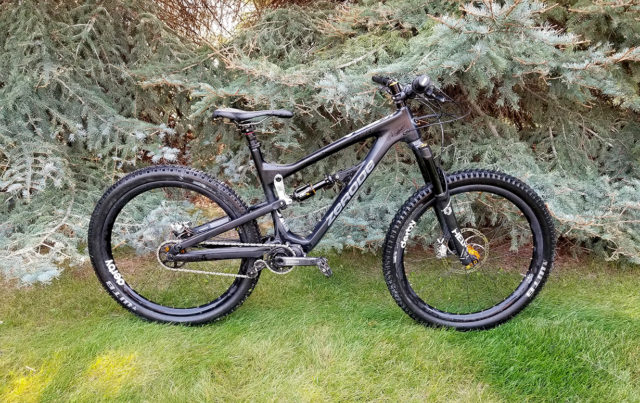
Intro
Hang on to your britches, because this is a long one. There’s a bunch of interesting stuff to talk about here, because there’s a lot going on with this bike. For those unfamiliar, Zerode hails from New Zealand, and they do things their own way. Among other things, doing things their own way means building bikes around a gearbox. So that means no derailleurs, no cassettes, and an entirely different way of shifting gears. It’s clearly different, and in a discussion with Rob Metz, one of Zerode’s founders, it’s pretty clear that the company was created out of a desire to build bikes that they personally wanted. If other people liked them, that’d be cool too.
Out of that philosophy, Zerode has developed bikes that focus on suspension prowess and durability. These are bikes that are built to tackle rough, technical trails, and they tend to be biased towards descending. Throughout Zerode’s history, they’ve built their bikes around gearboxes and internal shifting. The reason? Less maintenance, and by moving away from a traditional drivetrain, it opens up a lot of options in terms of suspension design.
A couple years ago, Zerode released the Taniwha (pronounced Tan-ee-fa), which was one of the first non-downhill bikes that was built around a gearbox. The Taniwha had 160 mm travel front and rear, and had 12 gears built into a gearbox located around the bottom bracket. We got a quick ride on the Taniwha at Interbike last year and came away fairly impressed — impressed enough to say that the suspension performs “ridiculously well.”
Fast forward to now, and Zerode has just released the new Taniwha Trail. It’s built around the same design as the original Taniwha, but it has a bit less travel at 140 mm in the rear. The idea is to keep things a little more efficient, and make the bike a bit more playful on flowier trails. I’ve spent about a month riding the Taniwha Trail on everything from cross-country rides to downhill laps in the bike park, so here’s what I concluded after getting to know the bike.
The Frame Design
The Taniwha Trail shares a nearly identical front triangle and gearbox configuration with the original Taniwha. The Taniwha Trail’s seat tube is a bit shorter, and the rear end gets a different linkage that reduces the travel and adjusts the geometry to be a little more trail friendly.
As with the original Taniwha, the Taniwha Trail’s frame is only available in carbon, and is built around a basic four-bar suspension design that works as a linkage-driven single pivot. Now, some out there may be slightly dismissive of a bike that doesn’t have a fancy, patented suspension linkage. Don’t be. Keep reading.
Of course, the most interesting aspect of the frame is the integration of the Pinion gearbox. Pinion makes a few gearboxes that will fit into the Taniwha Trail, but the one I rode included the C1.12, which has 12 internal gears shifted via a Pinion twist shifter. I’ll talk more about that system below, but as far as the frame is concerned, it’s cleanly integrated around the bottom bracket. The inclusion of a gearbox also means there’s nothing on the frame to accomodate a traditional drivetrain — the cable routing is designed for the gearbox, and there’s no derailleur hanger.
There’s enough going on with the Zerode frames that it’s easy to overlook the smaller details, but in terms of “normal” frame features, the Zerode is well thought out. The pivots are burly and produce a laterally stiff frame. Cable routing is internal with the exception of the rear brake, which stays external (but cleanly routed along the downtube). The Pinion shifter uses two cables, so there are two cables leaving the shifter. This makes for a more cluttered cockpit, but the cables go to the same place and can be taped together to keep things a little cleaner. And last, but certainly not least, the frame fits a water bottle.
Geometry and Fit
Both the original Taniwha and the Taniwha Trail are only available in three sizes, but they cover a pretty decent size spread (albeit with bigger jumps between sizes than you’ll see from most companies). Zerode doesn’t bother with naming their sizes Small, Medium, or Large — they just call out the sizes by the reach measurement, which is a great idea. So the Taniwha Trail comes in a 430, 455, and a 485, which are the reach lengths in millimeters for each respective size.
I rode the 455 mm Taniwha Trail, and I’d put the fit at somewhere between a Medium and a Large from most “average” brands these days. A reasonably steep 75.5° seat tube angle yields an average-ish top tube length — 617 mm on the 455 I rode.
A 66° head tube angle is fairly standard for a ~140mm-travel bike, so nothing too crazy there. Similarly, the bike’s 431 mm chainstays are pretty average these days, but it’s noteworthy that the gearbox unit doesn’t necessitate extra-long stays.
The Build
The Taniwha Trail I rode had a slightly different spec than the complete bikes that are available to purchase. Notably, the production version will be available with a 140 mm or 150 mm fork, and it will come with lighter tires.
My test mule was outfitted with Cane Creek suspension — a Helm fork and a DBair Inline rear shock. Project 321 hubs were laced to Derby rims and shod with a WTB Convict in the front and WTB Trail Boss in the rear. Magura MT Trail brakes took care of stopping duties. A 175 mm 9point8 Fall Line dropper post and a Syntace bar and stem rounded out the build. And, of course, the drivetrain is handled by the Pinion gearbox and shifter. This build is roughly similar to the Cane Creek Signature build offered by Cycle Monkey in the U.S., although the wheelset was different.
Most bikes I review these days have an assortment of parts from Sram or Shimano, with suspension from Fox or Rockshox. By and large, I get along fine with anything from those companies, and I’m fairly familiar with them which makes hopping on a new bike a bit easier. But that wasn’t the case with the Taniwha Trail — the only components on my test bike that I’d spent much time on were the WTB tires, and these ones were fairly worn. My point, mostly, is that there was a lot of new stuff to get used to on this bike.
The Cane Creek suspension was decent, but not mind blowing. This was the most time I’d spent on a Helm fork, and generally speaking, it’s a pretty good fork. The chassis is solid, the damping adjustments work well, and the ability to tune the negative air chamber is pretty slick. It’s not as smooth, nor does it have the small-bump sensitivity of the Rockshox Lyrik, but I had an easier time getting it dialed in than the lower-end Fox 36’s. I experimented with the travel on the Helm, and ran it at 160, 150, and 140 mm settings. Ultimately, I preferred the fork in the 150 mm setting and spent most of my time on the bike with the fork set at that travel.
The DBair IL rear shock has the excellent adjustability that’s typical of Cane Creek shocks, and it felt smoother than Cane Creek shocks I’ve ridden in the past. The climb switch is easy to access, and the switch is progressive, so it’s not just on or off. The big issue I had with the rear shock was deteriorating performance on longer descents — the shock got quite hot on any rough descent that lasted more than a few minutes, and suspension performance noticeably suffered. I also had the climb switch move on me once or twice — I started a descent with it open, and part way down the switch was partially closed. I’m not sure if it rattled into that position or a trailside bush snagged it, but either way, I’d like to see some detents added to help keep it in place.
The Magura brakes were another area where I struggled a little bit. Part of this was just lever shape, but part of it was that the front brake offers up a lot of power. I find that I can switch between Shimano and Sram brakes fairly effortlessly, but I had to re-adjust my finger pressure for the Maguras because I kept locking up the front wheel coming into corners. So yes, they work well. And I feel stupid complaining about a brake being too powerful, but I also feel stupid blowing every tight corner because I’m skidding my front wheel (although the worn-down Convict certainly takes some blame there too). Eventually, I learned to take it super easy on the front brake, but it was definitely an adjustment.
While I hadn’t spent much time on the Derby rims or Project 321 hubs, they were both great and worked flawlessly throughout the test. And while the WTB Convict front tire and Trail Boss rear tire probably wouldn’t be my first choice for this bike, they got the job done, and the Convict works well on the wider Derby rims.
The 9point8 dropper also worked without issue, and being able to run a 175 mm drop is fantastic. For my not-particularly-tall, 5’9” frame, the fact that the Taniwha Trail works with that much drop is worth noting.
Suspension
This is where things start getting interesting. There are a bunch of selling points for the gearbox drivetrain, but one of the biggest ones is that it transforms a lot of unsprung mass into sprung mass.
As far as suspension action is concerned, unsprung mass is bad. When your rear suspension hits a bump, everything that moves with the suspension is unsprung mass. So that means the bike’s rear end, the rear wheel, the rear tire, and (relevant to this discussion) the rear derailleur and cassette are all unsprung mass. More mass means more inertia, and more inertia means your suspension has a harder time tracking the ground smoothly.
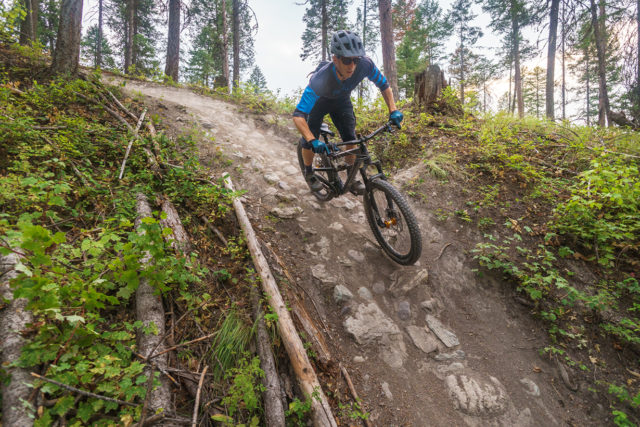
There’s a quick demonstration you can do to illustrate this concept. Hold your arm straight out in front of you with a pencil in your hand. Now move your arm up and down quickly — it’s not too hard. Now do the same thing with something heavy in your hand, like a book. It’s harder, right?
The same thing applies to your suspension — it’s a lever arm with your rear wheel at one end. The more mass that’s attached to the end of that lever arm, the more difficult it is for that arm to move up and down quickly. More mass means that the wheel will be less able to move up when it encounters a bump, and the shock will have to work harder to reverse that motion and push the wheel back down to the ground.
Now, the whole “reduce unsprung mass” thing was something that I’d always understood in principal, but I can’t say I’d ever noticed a particularly significant difference before. Switching to a lighter cassette or lighter derailleur never yielded an “ah-hah” moment where my suspension felt massively better. And switching to a lighter wheel or tire made a difference in acceleration, but maybe only a moderate difference for the suspension.
I haven’t run the calculations on it to put any actual numbers to the difference, but I can say with complete certainty that the lack of derailleur and cassette on the Zerodes makes a very noticeable difference. Particularly over small, rapid bumps, the Taniwha Trail levels the trail like no other bike I’ve ever ridden.
I’ll get into how that all plays out while riding a bit more below, but what’s interesting here is that the Taniwha Trail levels the trail ridiculously well, despite having only 140 mm rear travel, an air shock, and a fairly basic suspension design. This isn’t some super elaborate suspension design with a factory-tuned coil shock and 200+ mm travel. It’s a mid-travel Trail bike with a suspension design that’s been around for decades.
Now, I don’t mean to sell the suspension design short — it’s not a complicated design, but it’s clearly well executed. It’s mostly just that I’m fairly entertained by the idea that the best rear suspension I’ve ever ridden is a design that, to the best of my knowledge, was never patented and is in no way a “secret.” The difference is just in the drivetrain and the re-location of mass.
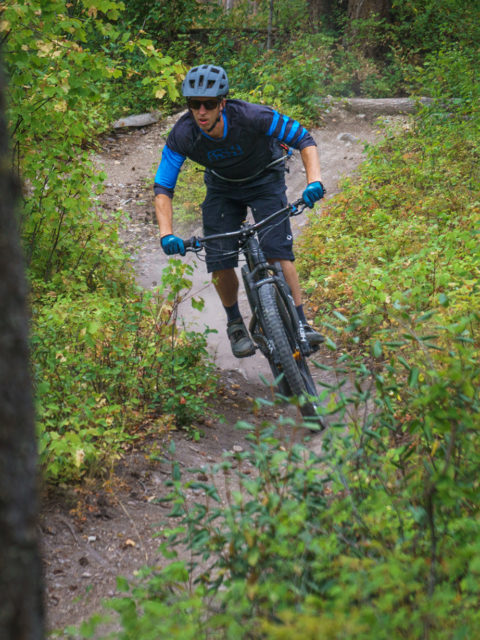
That does, however, bring up another interesting feature of the Taniwha Trail — the drivetrain’s effect on the suspension is the same in every gear. On pretty much every full-suspension bike out there, the force you put into the chain when you pedal will have some effect on the suspension. In terms of suspension kinematics, this is often discussed in terms of an anti-squat percentage. The more anti-squat a bike has, the more the chain forces tend to make the suspension lock out under pedaling, or sometimes (with a lot of anti-squat), the suspension will even extend. Bikes with less anti-squat will lock out less, and thus be more active while pedaling, which is good for absorbing bumps but bad for efficiency.
Different companies have different takes on how much anti squat is the right amount, and there’s a lot of personal preference there. But what’s interesting here is that a bike’s anti-squat characteristics are highly dependant on the angle of the chain relative to the bike’s pivot points and the rear axle. So that means, for a “normal” drivetrain, the anti-squat characteristics are different in the easiest gear compared to the hardest gear, because the chain is physically moving from a large cog to a small cog, and thus sits at a different angle relative to the pivot points. Plenty of suspension designers will take this into account and make the suspension more inclined to pedal efficiency in the easier gears while reducing the anti-squat in the harder gears so as to keep the suspension active while pedaling.
The point that I’m slowly working my way around to is that the chain on the Zerode doesn’t move; in terms of anti-squat, the Taniwha Trail is effectively a single speed, which means it’s the same in every gear. This means the Taniwha Trail has to balance pedaling efficiency with an active suspension for all gears, without the benefit of the chain angle changing in the harder gears. More on how that plays out on the trail below.
The Gearbox
Given that this bike is built around a Pinion gearbox and that gearbox really defines most of the upsides (and downsides) of the Taniwha Trail, a discussion of the gearbox warrants its own section.
The basic premise of the Pinion gearbox is that all shifting is done inside a sealed case that surrounds the bottom bracket. Shifts at the handlebar alter the drive ratio within the gearbox, but the box is closed up so there’s no real visible indication that a shift has occurred. Gear ratios are achieved by shifting between different sized cogs, all of which are concealed within the case. The cogs drive the chainring, which is not fixed to the crankarm. You can see in the video below, the chainring spins at a different speed than the cranks, and depending on what gear you’re in, the chainring will spin slower (for an easier gear), or faster (for a harder gear, as shown in the video).
Pinion makes a few different gearboxes that fit the Taniwha trail, and Zerode offers the bike with both a 12- and 9-speed version. The 12-speed version that I rode has a 600% range, while the 9-speed version is a bit cheaper and has a 568% range. For reference, a Sram Eagle drivetrain has a 500% range.
In terms of gearing, the 12-speed Pinion C1.12 that I rode has an easier “easy” gear and a harder “hard” gear than a normal Sram Eagle drivetrain. Now, the Eagle drivetrain’s range can be made easier or harder by switching to a smaller or larger chainring, but the overall range of the Pinion will always be larger.
Similarly, the Pinion’s gearing can be made easier or harder by altering the chainring and rear cog. On my test bike, there was a 1:1 ratio, meaning the chainring and cog were the same size. But by (for example) making the rear cog larger or smaller, the gearing range can be made easier or harder.
Aside from the effect on the suspension that I discussed above, the gearbox has a few noteworthy benefits. For starters, as a sealed unit, it’s fairly maintenance free. Pinion recommends that the oil inside the unit be changed every year, but other than that, there’s not much maintenance to be done. Perhaps more importantly, there’s also not much to break on the unit in a crash — there’s no derailleur hanging off the bike, and all of the moving parts (except for the shifter) are tucked away inside the case.
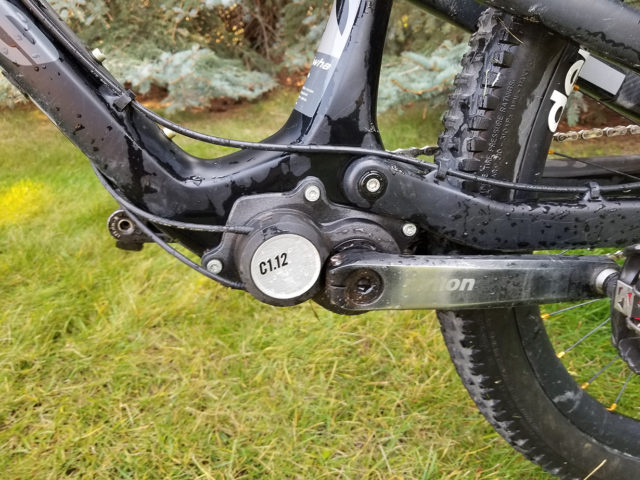
The gearbox also can shift without pedaling — there’s no chain to move from cog to cog on the cassette, so you can shift to any gear while coasting, or even while just standing next to the bike. But that’s our segue into (arguably) the biggest downside of the gearbox — it really doesn’t like to shift under load. It’ll shift while pedaling if you’re not putting any real force into the pedals, and it shifts to a harder gear under load more readily than it shifts to an easier gear. But pedaling up a steep hill and popping through gears to get to an easier climbing gear takes a particular technique. Even under relatively light loads, the gearbox really doesn’t like to shift — what I would call a “normal” load to get a clean shift on a traditional drivetrain would be too much load to get the gearbox to shift.
On mellow dirt-road climbs, I didn’t find this to be too problematic — you just have to time a brief pause in your pedal stroke with the shift. But on super steep climbs where any pause in the pedal stroke effectively brings you to a complete stop, this gets trickier. Mostly, I found I had to plan a little farther ahead and make sure I was already in the right gear when the going got legitimately steep.
The other big downside, at least for me, is that the only shifter option available for the Pinion gearbox is a twist shifter. Sometime around 1998, I decided that Gripshift was stupid. After revisiting the concept 20 years later, I’ve concluded that I was correct the first time around. Yes, twist shifters allow you to go from your easiest gear to your hardest gear with a flick of the wrist. Which is cool, except I almost never do that while actually riding the bike. Rather, I want to be able to click off one or two shifts at a time, and I find that while bouncing down a bumpy trail, I tend to overshift with the twist shifter and end up in the wrong gear.
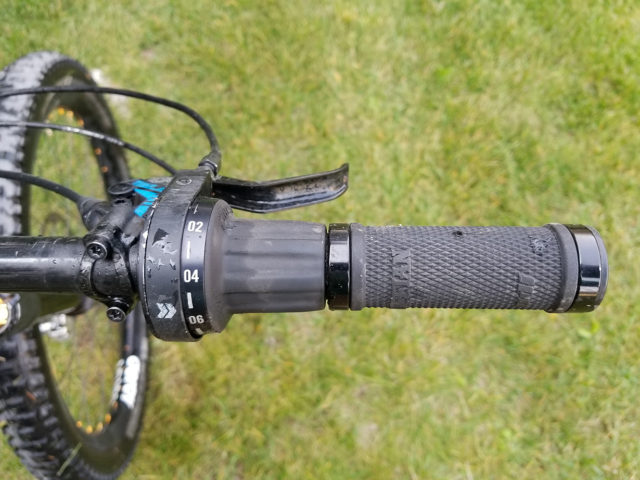
My bigger issue with the twist shifter is that it requires me to take my pointer finger off the brake lever to make a shift, and that I have to compromise my hand position on the bar. Now, to be fair, I’ve talked to some twist-shifter aficionados who have modified their shifters so that they can twist it with that flap of skin between their thumb and pointer finger, and without having to take their finger off the brake. I was on a demo bike, so I couldn’t really experiment around with shifter and grip modifications. But I do know that I’ve never had to modify any of the modern trigger shifters to work easily, and I never end up with my hand rolled forward on the bar after a shift.
Pinion has been talking about releasing a trigger shifter for quite a while now, but thus far it hasn’t seen the light of day. They can put me down in the “interested” column.
There are a couple other downsides of the gearbox that are worth mentioning. The obvious one is the weight — depending on how you count it, the C1.12 gearbox weighs at least 800 grams more than a comparable external drivetrain. That’s not insignificant, but it didn’t actually bother me that much on the trail, which I’ll get into more below.
There’s also some drag in the gearbox — it’s not the same in every gear, but it’s definitely more than a traditional drivetrain. There are a lot of factors that affect how much drag a given drivetrain has, but on average, most of the numbers I’ve seen indicate that the Pinion gearbox is maybe 5-8% less efficient than a traditional external drivetrain. When I first rode the Taniwha at Interbike last year, I didn’t really notice that drag. And on more technical singletrack, it’s not super noticeable — brief bursts of pedaling and concentrating on not smashing into rocks mean that my attention is devoted elsewhere, and drag isn’t really an issue. But while pedaling up smoother dirt-road climbs, it’s definitely noticeable. It’s difficult to quantify, but on climbs that I’ve done hundreds of times, and riding with friends whose pace I’m familiar with, I feel like I’m working harder on the Taniwha Trail, and I think that’s mostly attributable to drag in the gearbox.
Another associated issue is that the gearbox makes a bit of a “whirring” noise while pedaling. The noise changes a bit in different gears, and it’s not annoyingly loud, but it’s definitely there. On one group ride, the guy riding next to me kept thinking his rear tire was leaking air until he finally figured out it was just Zerode’s gearbox making the noise. People who insist on a silent bike might be annoyed by it, but for me, it’s more that the gearbox sounds inefficient. I know this is just a mental thing, but it’s something I struggled with a little bit.

I also found that there were a few places in the middle of the gear range where I was wanting a ratio that wasn’t there. As I mentioned above, the C1.12 gearbox has a 600% range, which is 100% more than a Sram Eagle drivetrain. But both the C1.12 gearbox and Eagle have 12 gears, which means the gearbox has bigger gaps between each gear in order to achieve that wider range. In the easier gears and the harder gears, I didn’t really notice this to be an issue. But in the middle gears, on flat and mildly rolly terrain, I often found myself searching for a gear ratio that wasn’t there. One gear was a bit too easy, and the next gear was a bit too hard — the jump in between them was too large. This is a relatively minor gripe, but people who are picky about their cadence should take note.
Another issue I had with the gearbox was the engagement. On a normal drivetrain, freewheeling is only accomplished at the rear hub, and how quickly the drivetrain engages is dictated by how many engagement points are in the freehub. DT Swiss is notoriously low with 18 engagement points and Industry 9 is notoriously high with 120 points. The Project 321 rear hub that was on my test bike had great engagement, with 144 engagement points. But unlike a normal bottom bracket, the Pinion gearbox also freewheels — when you backpedal, the chain doesn’t move; there’s a ratcheting mechanism in the gearbox that allows the cranks to backpedal while the chainring stays in place. And the problem here is that the gearbox only has 16 points of engagement, which is fairly terrible. Particularly on technical climbs that might require ratcheting the pedals, the lack of quick engagement in the gearbox makes things noticeably more difficult.
The last issue I have with the gearbox is an easier fix — neither the rear cog nor the chainring had a narrow / wide tooth profile, and I dropped the chain a couple times. The Taniwha Trail has a built-in chain tensioner that generally works pretty well, but pedaling through rough, brake-jacked descents where the rear wheel was flopping around a bunch left me chainless a couple times. The chain seemed to be falling off the rear cog first, and I think a basic narrow / wide cog and ring would likely solve this problem pretty easily.
The Ride
We’re in pretty deep at this point, and we’ve gone over a lot of the upsides and downsides to the bike, so let’s get to the point already.
The rear suspension on this bike is insanely good. In terms of the suspension, it’s the best 140 mm bike I’ve ridden, and it easily beats out any number of longer-travel bikes as well.
My first ride on the Taniwha Trail was at a local trail network that has a fire road climb, followed by a little bit of singletrack climbing, and then a bunch of descending options. Climbing up the fire road, the bike seemed fine, but not mind blowing in any particular way. I was still getting used to the twist shifter, and noticed a bit of drag out of the gearbox. But then I got onto the singletrack. This particular bit of trail is short, fairly flat, and has a bunch of little bumps in it. It’s not rough or technical, it’s just kinda lumpy, and that’s noticeable on even longer-travel Enduro bikes. It’s the kind of trail where, on a hardtail, I end up standing up not because the trail is fast or rocky, but because it’s bumpy and it hurts my ass.
But on the Taniwha Trail, it was completely smooth. All of that lumpiness just disappeared — the rear wheel tracked the ground unlike any other bike I’ve ridden on that trail.
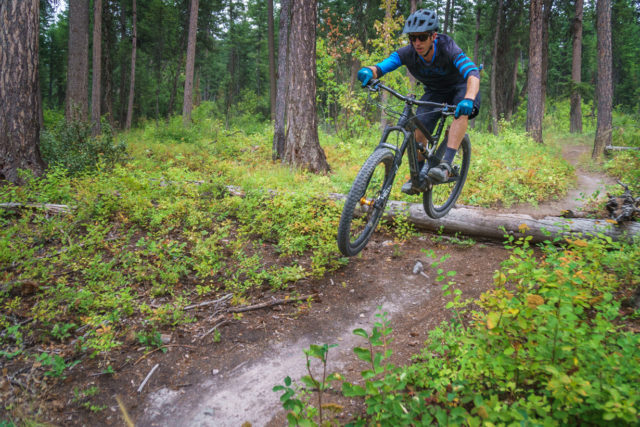
And that pretty much sums up what’s so impressive about the Taniwha Trail — when it comes to smaller bumps, they just disappear. Roots, rocks, braking holes, squirrels — they’re just gone. And sure, there are plenty of bikes I’ve ridden that have excellent rear suspension, and many of those do quite well over small bumps. But what I’m saying is that the Taniwha Trail is on a different level.
This was probably most evident at our local bike park in late August. As will happen, most of the trails were hacked to shit and full of dusty brake bumps. I rode those trails back to back on my DH bike (a Devinci Wilson) and the Taniwha Trail, and in terms of making the brake bumps disappear, the Taniwha Trail was very nearly as good as the Wilson. To put it another way, the Taniwha Trail was very nearly as good as a bike with 60 mm more travel and that’s running Fox’s top of the line coil shock. That’s super impressive.
And all of that small and midsize bump-sucking prowess means the Taniwha Trail is super composed through chop, and the rear wheel maintains traction unbelievably well. On a lot of bikes, even longer-travel Enduro bikes with great suspension, coming into a choppy corner involves an expectation that, at some point, the rear end is going to get bounced off a bump and kick out a bit. The Taniwha Trail doesn’t really do that, or at least, it takes a pretty significant event to make it happen. For the most part, the rear end just goes where you tell it to, regardless of lumpiness, roots, or other mid-corner chunder.
Now, on bigger hits, that difference mostly disappears. The noticeable benefits of Zerode’s suspension design and lack of unsprung mass are mostly limited to small- and medium-sized hits — on bigger stuff, the suspension still does fine, but it’s more or less comparable to any other well-designed 140mm-travel bike on the market. It doesn’t blow through it’s travel, and the overall leverage ratio is decently progressive, but the Taniwha Trail isn’t groundbreaking in this regard.
In terms of suspension, the main thing I noticed was that the front suspension couldn’t really keep up with the Taniwha Trail. The Cane Creek Helm isn’t a bad fork, but it doesn’t smooth out terrain nearly as well as the Taniwha Trail’s rear suspension. And that situation led me to ride the bike a bit oddly — particularly at higher speeds, I started adopting a more off-the-back riding position. The goal was to get the front end through obstacles with a light touch, and then smack into things with my weight over the rear. Because, by and large, the rear suspension would handle those hits without even flinching. But it does make me want to try the Taniwha Trail with one of the new Lyrik RC2’s, which offer small-bump sensitivity that might be able to keep up with the bike’s rear end.
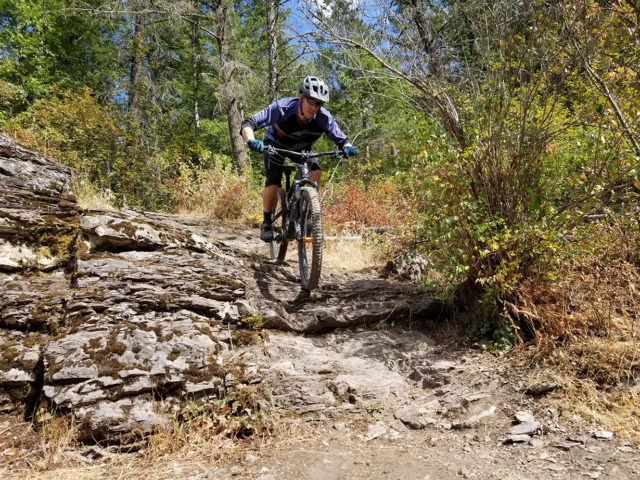
And like the original Taniwha that I rode, the Taniwha Trail is impressive in that, for all of the suspension’s stick-to-the-ground awesomeness, it still pops and jumps just fine, and it doesn’t feel like a plow bike. The Taniwha Trail doesn’t achieve its plushness by some stupid regressive leverage ratio that makes the bike un-fun to ride — it gets there mostly by shifting weight around, which doesn’t negatively impact the bike’s ability to pop, pump, and play around on trail features.
Now, plenty of people are going to be quick to question the Taniwha Trail’s weight — it’s pretty heavy on my scale at 33.8 lbs (15.33 kg) without pedals. Now, that comes with the caveat that my test bike didn’t have the same parts the stock versions will have, and it wouldn’t be hard at all to shave about a pound of weight off of that build without getting into titanium bolts and speed holes. But regardless, 33-ish lbs is still pretty porky for a 140 mm travel bike, particularly one that costs over $8,000.
But I’ll admit, I didn’t really notice the weight. Sure, no one’s going to mistake this thing for a sub 25 pound XC bike, but the weight from the gearbox is low and centered, and the Taniwha Trail didn’t “ride heavy,” or at least it didn’t feel noticeably heavier than any of the other 30-ish lb bikes I’ve been on recently. The extra weight is low and centered around the gearbox, and that actually goes a long way towards making it matter less.
But not all of that weight is from the gearbox — I’m sure some of the weight is hidden in the Taniwha Trail’s frame, because the frame is quite solid. It’s easy to get wrapped up in the gearbox and suspension bits on this bike, but it’s worth noting that the frame is impressively flex free. Pushing it sideways into corners didn’t reveal any twisting, and I’d say the frame is built a bit more stout than most bikes in this travel class.
In terms of the bike’s handling and geometry, the Taniwha Trail falls more on the playful end of the spectrum. By the numbers, the Taniwha Trail is pretty average among bikes in this travel class, but it feels a little smaller, and a little more maneuverable than the numbers suggest.
On one hand, this is a good thing — the fact that the bike feels a bit more whippy and maneuverable is noteworthy given its weight. And it also means that the Taniwha Trail is, pretty clearly, distinguishable from its bigger brother, the 160mm-travel Taniwha. But given some of the inherent downsides of the gearbox that tend to make a bike like this make more sense for mostly descending-oriented pursuits, it also makes me think that I’d generally opt for the longer-travel Taniwha over the Taniwha Trail unless I lived in a place where the more trail-oriented handling of the shorter-travel rig was a big priority.
Putting the bike’s suspension prowess and handling aside for the moment, the Taniwha Trail is not without its quirks. As I got into a bit above, the shifting takes a lot of getting used to. A pretty frequent scenario was that I’d come out of a descent into a climb that gets progressively steeper. As I slowed down, I’d starting popping through the gears, one at a time. Somewhere in that progress, I’d miss-time my shift and the gearbox would refuse to shift under load. I’d then be left with the choice of toughing it out in too hard of a gear, or pausing pedaling to get the shift in, which would kill all of my precious momentum. People who have spent a lot more time on gearbox bikes are better about timing their shifts than I am, but there’s a substantial learning curve that can be pretty frustrating at times. And all of this is accentuated by the twist shifter, which still just seems like a less efficient way to click through gears than a normal trigger shifter.
Shifting issues notwithstanding, climbing on the Taniwha Trail goes pretty well. The bike is fairly efficient, and for the most part, I didn’t feel the need to use the shock’s climb switch very often. On smoother climbs, some bobbing was noticeable, but it’s not terrible by any means. There are certainly bikes in this travel class that are more efficient, but there are quite a few that are less efficient as well.

As I mentioned above, the gearbox drivetrain means that pedaling efficiency stays the same regardless of what gear you’re in, which potentially could mean the suspension wouldn’t work quite as well. I can’t say I noticed this, or more accurately, if the drivetrain was interfering with the suspension’s movement, then I’m even more impressed because the suspension still felt really, really good.
Given that the Taniwha Trail uses a linkage-driven single-pivot design, some people may also be a bit skeptical of the bike’s handling while hard on the brakes. The Taniwha Trail is probably a bit less active under hard braking than some other bikes on the market, and it’ll tend to squat a bit more, preserving the bike’s geometry when you’re braking hard into a corner. This tends to be a personal preference thing, but my take is that it’s one of the easier things to adapt to while riding.
I’ve ridden lots of different bikes that all behave a bit differently while braking, and I can’t say that any of them yielded a “eureka” moment where I declared that system to be a winner. And while, by the numbers, some bikes are more active under hard braking, the Taniwha Trail’s suspension is more active in general due to the reduced unsprung mass, so I’d say that it’s actually one of the smoother bikes I’ve ridden with respect to braking, even though the suspension design isn’t the most active in that situation.
Taniwha vs. Taniwha Trail
One of the big questions I had while riding the Taniwha Trail is: what does it offer that the original Taniwha doesn’t? To be sure, the Taniwha Trail feels like a more agile bike that pumps better, pops better, and feels more at home on tighter trails. But it’s still a bike that feels most at home on rough descents where the its suspension prowess matters most. And when it comes to rough trails, I’d still opt for the longer-travel Taniwha in most situations, even if it means giving up a bit of ground in tighter situations and on flowier trails.
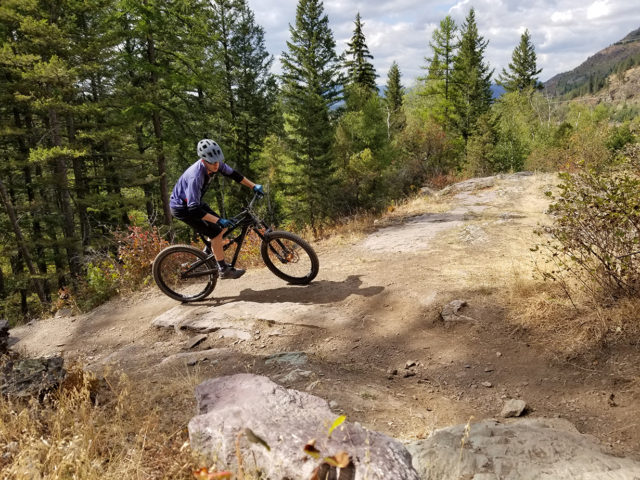
So I think most people that are taking a serious look at the Taniwha family will probably opt for the original, longer-travel version. But I could see the Taniwha Trail being a good option for some of the trails in the Northeast U.S., or even some of the trails around coastal British Columbia. I’m thinking of trails that tend to be slower speed, super technical, and have a bunch of moves that could almost be called trials-y. There, the slightly steeper angles of the Taniwha Trail will help in tight situations, and the slacked-out stability of the original Taniwha might be somewhat less necessary. I could also see the Taniwha Trail being a good option for people who’s local trails tend to alternate between flow and slow-speed chunkiness. Having a bit less travel, the Taniwha Trail is a bit more fun on flow trails, and on slow-speed tech, the Taniwha Trail’s geometry feels more manageable.
Bottom Line
I’ll admit, I’m struggling to come to a nice, tidy conclusion on the Taniwha Trail. On one hand, the rear suspension is clearly superior to any other bike in this travel class that I’ve ridden — it absorbs bumps and maintains traction better than any other ~140mm-travel bike I’ve been on, and the suspension is still decently efficient while pedaling.
On the other hand, the gearbox has some pretty obvious downsides. The combination of a bit of drag, not being able to shift while pedaling, and the clunky twist shifter make for a situation that I could never quite come to terms with. Yes, the gearbox also has some noteworthy upsides beyond its benefits to the suspension — it’s relatively maintenance free, it’s not particularly susceptible to crash damage, and you can shift while coasting. But at least for me, the downsides of the drag and shifting idiosyncrasies outweighed the maintenance and durability upsides of the gearbox.
So that leaves me with the conundrum: does having the best suspension I’ve ever ridden outweigh a shifting system that falls somewhere between “takes some getting used to” and “annoying”?
I think the answer to that varies a lot from person to person. I have ridden with people that are fully on board with gearboxes — the shifting issues I’ve described aren’t something they hang up on, and for them, the benefits far outweigh the downsides. Personally, I think the Taniwha Trail is an excellent example of what gearboxes have to offer, but I think gearboxes need to be a bit more refined before they’re going to enjoy broader acceptance.
But more to the point, who should seriously consider this bike? For starters, I think it’s someone who clearly prioritizes suspension and downhill prowess over winning the race up the climbs. It also needs to be someone with an open mind, who’s willing to try (and adapt to) something different. And anyone who is a persistent breaker of bikes should take a look at the Zerodes — the frames are burly, and there’s a distinct lack of fragile componentry dangling off of the bike.
While those criteria narrow down the list of people who are really going to be psyched on the Taniwha Trail, there’s no question that it offers something significantly different from the majority of what’s on the market. It’s not for everyone, but if you resemble the description above, and if you’re looking for something that’s not just a minor tweak to Generic Bike X from Huge Company Y, the Taniwha Trail might just be what you’ve been looking for.

I love that somebody has the guts to make a bike like this, but until they have a sub-28 pound, 130 mm 29er that retails for $6k or so, I’ll just have to keep wondering how great that rear suspension really is.
Oh, and no twist shifter. Ever again.
Thanks for the detailed review!
Comprehensive review. Nice. I’ve had a Taniwha over a year now. It took quite a while to get used to the gearbox and shifting but now wherever i get on a derailleur bike the trigger shifting is annoying and janky. The gearbox is way smoother and i can change gears while pedaling (or cornering, or in the air) without thinking about it. I think that’s mostly about habits and what you’re used to.
But, if people measure a bike simply by how it changes gears they’re kind of missing the point. It’s always fun getting to the bottom of the hill and waiting for your buddies to turn up on their clunky santa cruz/transition/trek/whatevers then asking what took them so long. Especially on super rough tech trails, the Taniwha leaves everything else for dead, and that’s the bottom line.
Pro tip, run a coil fork – no air fork can match the rear suspension.
Great to hear from an actual owner. Every description I read about the rear sus calls to my old(ish) body!
If someone made a proper 7 speed gearbox downhill bike, that thing would kick ass.
Gwin crushed Leogang with no chain… and at the bottom said his suspension was amazing for that very reason. I dunno if gearboxes are the right choice for trailbikes, but for downhill bikes, I am very surprised no one has taken a serious stab at it yet.
Quite a good review but he didn’t adapt to the gearbox. The whirring on the uphill is not annoying. No mention of the zen silence and calm as you tear down the track leaving all others in your dust. My Taniwha has 5000k on the clock and really only brake pads and fork servicing. A very robust and hard charging bike which makes you feel like a champion even when you are quite average.
Where the closing paragraph states, “who should seriously consider this bike?” I think one of the major upsides of the bike is left out (and the reason why I have been waiting for someone to make a bike like this for 10 years). The gearbox and belt drive are super-duper reliable and maintenance free. A person like myself who would like to spend 100% of the time riding the bike and 0% of the time fixing it would love a gearbox bike and be willing to overlook some of the more annoying aspects of shifting (not a big fan of grip shifters). Not to mention reliability of shifting.